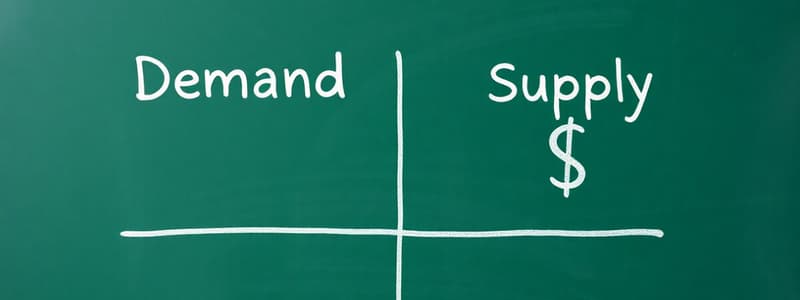Podcast
Questions and Answers
Which of the following best describes the Law of Demand?
Which of the following best describes the Law of Demand?
- As price decreases, quantity demanded decreases.
- As price increases, quantity demanded increases.
- As price decreases, quantity demanded increases. (correct)
- Quantity demanded remains constant regardless of price.
A surplus occurs when the quantity demanded exceeds the quantity supplied.
A surplus occurs when the quantity demanded exceeds the quantity supplied.
False (B)
What is microeconomics primarily concerned with?
What is microeconomics primarily concerned with?
Individual economic agents and their interactions.
The quantity of a good or service that producers are willing and able to sell at various prices is known as _____.
The quantity of a good or service that producers are willing and able to sell at various prices is known as _____.
Match the following concepts with their definitions:
Match the following concepts with their definitions:
Flashcards are hidden until you start studying
Study Notes
Overview
- Microeconomics studies individual economic agents and their interactions.
- Focuses on supply and demand, consumer behavior, and the allocation of resources.
Key Concepts
-
Demand
- Definition: The quantity of a good or service consumers are willing and able to purchase at various prices.
- Law of Demand: As price decreases, quantity demanded increases, and vice versa.
- Shifts in Demand: Changes due to consumer income, preferences, prices of related goods, etc.
-
Supply
- Definition: The quantity of a good or service that producers are willing and able to sell at various prices.
- Law of Supply: As price increases, quantity supplied increases, and vice versa.
- Shifts in Supply: Caused by changes in production costs, technology, and number of sellers.
-
Equilibrium
- Market Equilibrium: The point where supply equals demand.
- Equilibrium Price: The price at which the quantity demanded equals quantity supplied.
- Surplus and Shortage: Surplus occurs when supply exceeds demand; shortage occurs when demand exceeds supply.
-
Elasticity
- Price Elasticity of Demand: Measures responsiveness of quantity demanded to price changes.
- Elastic (>1): Quantity demanded changes significantly with price change.
- Inelastic (<1): Quantity demanded changes little with price change.
- Price Elasticity of Supply: Measures responsiveness of quantity supplied to price changes.
- Price Elasticity of Demand: Measures responsiveness of quantity demanded to price changes.
-
Consumer Behavior
- Utility: Satisfaction received from consuming a good or service.
- Marginal Utility: Additional satisfaction gained from consuming one more unit.
- Law of Diminishing Marginal Utility: As more of a good is consumed, the additional satisfaction decreases.
-
Production and Costs
- Factors of Production: Land, labor, capital, and entrepreneurship.
- Short-run vs. Long-run Costs: Short-run involves fixed and variable costs, whereas long-run involves variable costs only.
-
Market Structures
- Perfect Competition: Many firms, identical products, free entry and exit.
- Monopoly: One firm, unique product, significant barriers to entry.
- Oligopoly: Few firms, may produce identical or differentiated products, significant market power.
-
Market Failures
- Occurs when the allocation of resources is not efficient.
- Common causes: Externalities (positive and negative), public goods, and information asymmetry.
-
Government Intervention
- Purpose: Correct market failures, promote equity, and stabilize the economy.
- Tools: Taxes, subsidies, price controls, regulations.
Key Models
- Consumer Choice Model: Analyzes how consumers maximize utility subject to budget constraints.
- Production Possibility Frontier (PPF): Illustrates trade-offs between two goods, showing maximum efficient production levels.
Important Theories
- Marginalism: Decisions based on the additional benefits versus additional costs.
- Incentives: Changes in incentives can significantly influence behavior of consumers and producers.
Applications
- Analyzing pricing strategies, consumer choice, and understanding the implications of policies affecting supply and demand.
Microeconomics Overview
- Studies individual economic agents and their interactions.
- Focuses on topics such as supply and demand, consumer behavior, and the allocation of resources.
Demand
- The quantity of a good or service consumers are willing and able to purchase at various prices.
- The Law of Demand states that as price decreases, quantity demanded increases, and vice versa (holding all other factors constant).
- Shifts in demand can be caused by changes in consumer income, preferences, prices of related goods, and other factors.
Supply
- The quantity of a good or service that producers are willing and able to offer for sale at various prices.
- The Law of Supply states that as price increases, quantity supplied increases, and vice versa (holding all other factors constant).
- Shifts in supply can be caused by changes in production costs, technology, the number of sellers, and other factors.
Equilibrium
- Market equilibrium is the point where supply equals demand.
- The equilibrium price is the price at which the quantity demanded equals the quantity supplied.
- A surplus occurs when supply exceeds demand, leading to a downward pressure on prices.
- A shortage occurs when demand exceeds supply, leading to an upward pressure on prices.
Elasticity
- Price Elasticity of Demand measures the responsiveness of quantity demanded to changes in price.
- Elastic demand (>1) is characterized by a significant change in quantity demanded in response to a price change.
- Inelastic demand (<1) is characterized by a relatively small change in quantity demanded in response to a price change.
Studying That Suits You
Use AI to generate personalized quizzes and flashcards to suit your learning preferences.




